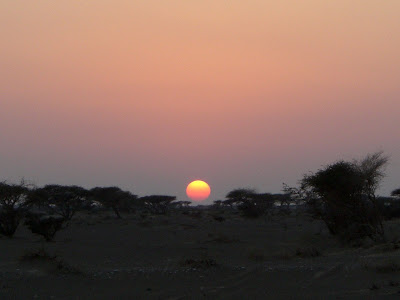The Sultanate of Oman is about the size of Germany but with only 7 inhabitants on a sqkm (instead of 220). There are magnificent mountainous regions, coastlines inviting you to snorkeling in clear, glittering water, ancient settlements, prehistoric tombs, lively souqs and the beautiful deep orange sanddunes of the deserts.
If you like driving along graded tracks that snake through narrow gorges, up hairpin bends or down into wadi beds, if you're in for staying at the desert camp with Beduins, if you enjoy watching farmers negotiating at the live stock market or walking through abandonned mudbrick villages, if you want to have a "get-away-from-it-all" adventure holiday, Oman is the place you should go to.
Unity of traditions and modern life-(style)
Until Sultan Qaboos took over in 1970 live in Oman was far from what it is today. There were apart from the Quran Schools only 3 boy schools, one hospital, one hotel, one post office and 10 km of paved roads. People werent't allowed to ride bikes, own a radio, books or TV nor wear sunglasses. There was no running water installed in the houses nor electricity. People lived of agriculture and fishing, also trading and crafts.
1970 was the beginning of the "Oman renaissance". Within 30 years the somehow middleaged country walked right into the 21th century. Sultan Qaboos did and still does invest the "petrodollars" in the development of education, healthcare, traffic, economics, agriculture, tourism and at the same time in keeping up national heritage and culture.
All this could only be achieved by employing thousands of workers from India, Pakistan, Bangladesh, Sri Lanka and the Philippines and foreign experts, the socalled "expatriates". Today more than 50% of the Omanis are under 18 and when it comes to employment "Omanisation" becomes a key word.
Our route
The first few days we spent at the Musandam Peninsula, the smallest and most northerly region of Oman. It is separated from the rest of the country by the United Arab Emirates and dominated by the Hajar mountain range. The coastline has fingers of fragmented rock creating long fjords and inlets. Crossing over to the "mainland" of Oman, we stopped at the town Fujairah (UAE) to visit Al Hayl Palace and watch an arabian bullfight (with the local spectators being more interesting than the fight itself...).
Our first real offroad adventure took us into Wadi Bani Awf where we camped for 3 nights. Snake Canyon and the mountain village of Balad Seet were the major highlights.
Next we went to the "capital area" around Muscat. The "old town" itself today only houses representative government buildings and the palace. It seems somehow sterilized and without any life at all. Life you'll find in the small towns, like Mutrah around Muscat, in the "capital area". You recognize it as soon as you enter it - kms of well kept flowers and roundabouts with sculptures showing monuments and traditional objects.
At Ras al-Jinz we booked a tour to watch the Green Sea Turtle while nesting and hatching. To protect the 30000 nests in this area a nature reserve had been installed and a science and visitor centre had been opened. That night we stayed in a desert camp.
In Wadi Bani Khalid we thought we'd experience a refreshing bath in one of its nature pools. But to our surprise the water was warm!
When looking for a desert track near Al Mintirib the next day we got to know Salim. While our bikes were safe in his backyard, he took us 7,5 km into the desert "Ramlat al-Wahiba" where we spent the night up in the sanddunes. He returned with some friends later that evening and we sat around the fire together. The next morning he came to fetch us right in time to share breakfast with us.
From Nizwa we went to see places like the abandonned mudbrick town of Manah, the Palace of Jabrin and Bahla Souq, the Al Hoota Cave, the live stock market at Nizwa and the ancient tombs in Wadi Dam.
We also enjoyed the winding roads up to Jabal Shams (3009 m), Jabal Akhdar (2009 m) and another view-point high up in the Hajar mountain range. Unfortunately the captain in charge would not let us pass the checkpoint to the road to Jabal Akhdar's Saiq Plateau with the bikes. "Do have 4WD?", he asked. How that, we are riding motorbikes!!!!! We didn't succeed in persuading him so we had to hitchhike.
Camping
There are no offical campsites in Oman, but if you keep to the common rule to leave nothing than footprints and take nothing than pictures, you can camp nearly everywhere. Most of the nights we spent in Wadis, enjoying a lovely campfire and clear stary skys. Daylight is from 6 am to 6 pm and it takes us two hours each set up and leave the place. On the bikes we can carry water and food for two days only, so you have carefully to plan your route every night.
Conclusion
Oman is well worth a visit - but don't wait too long! Things will change and not all of them to the better!!!
Back in Dubai
Back in Dubai we once again were invited to stay with Doris and Florent. There we got the bikes ready for their trip to India, had our clothes washed and gear cleaned. We were free to come and go as we liked and were also allowed to use the car. We want to thank the two of you and Alona for all the help you offered! You were the right people at the right place and time and it is a pleasure that we have got to know you - and Coco - and Luis...!!!!



















































